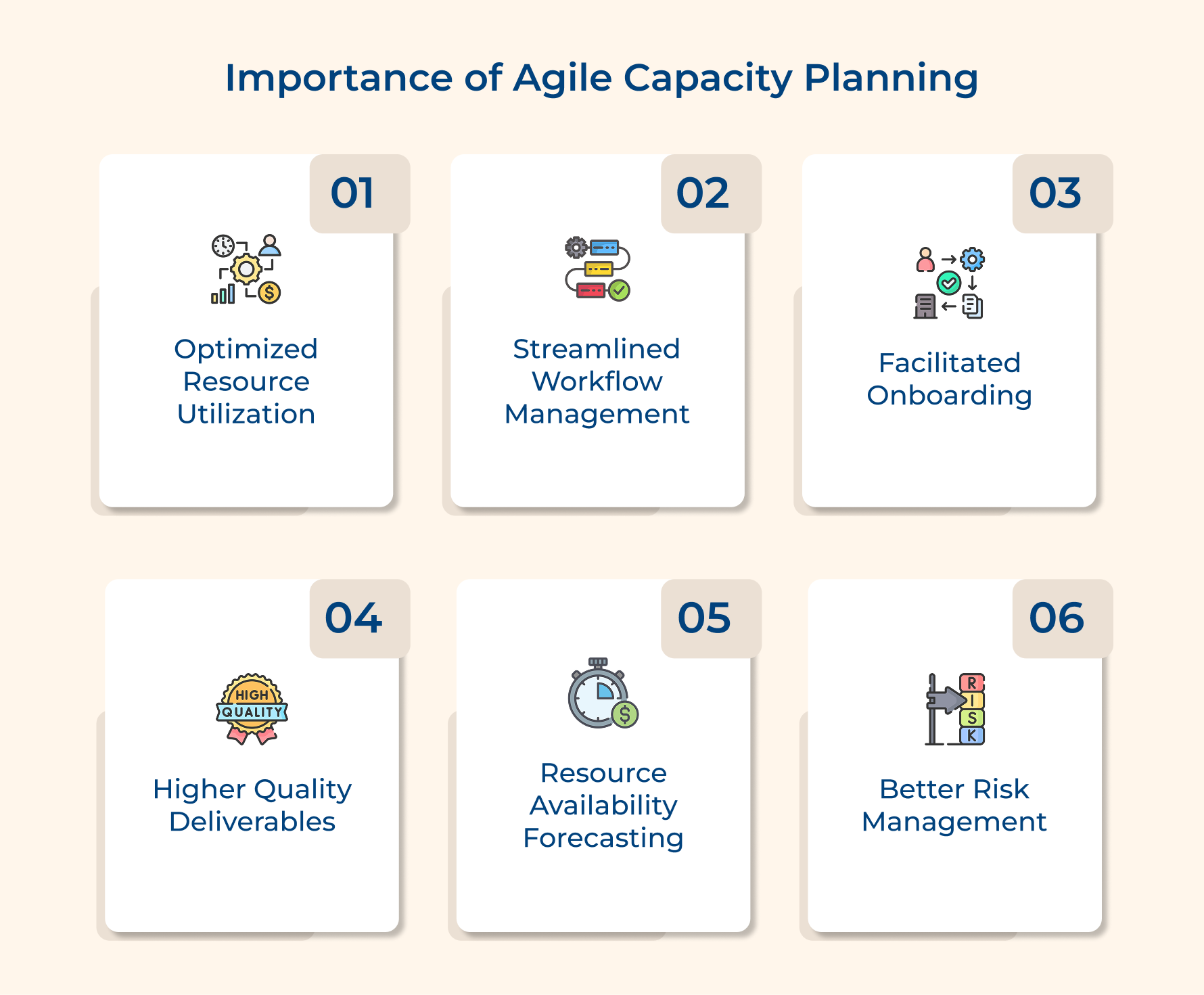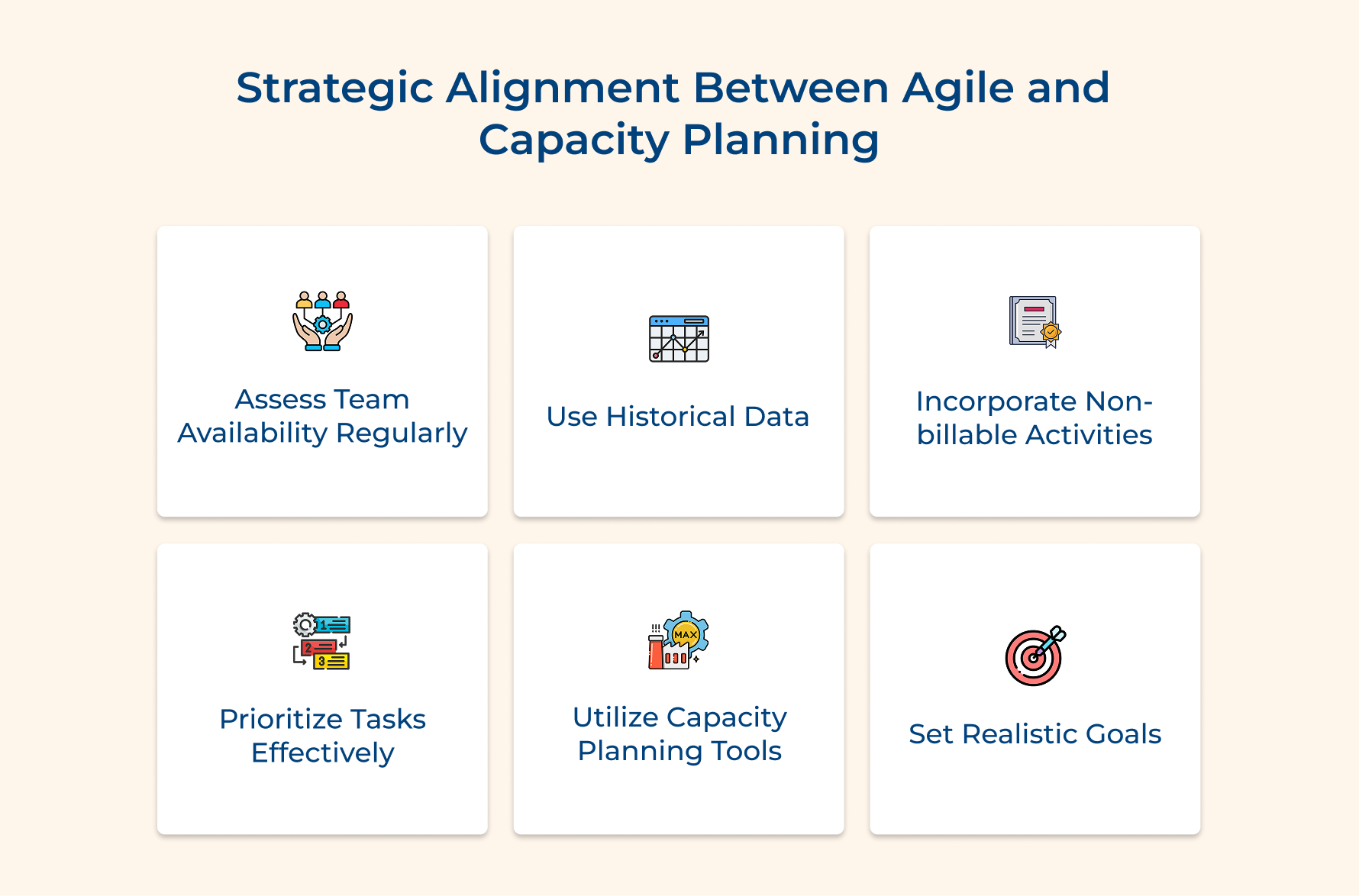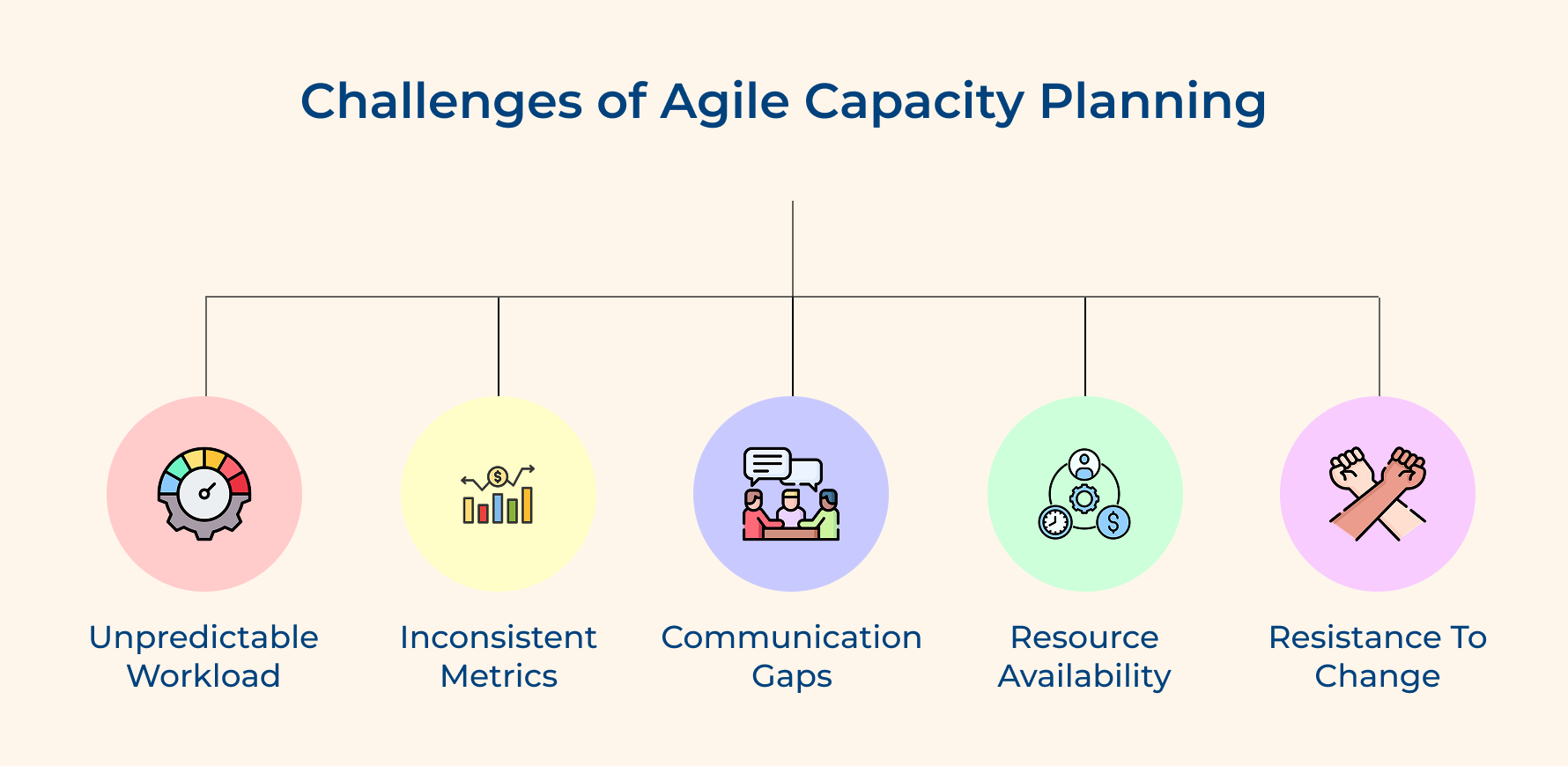Agile Capacity Planning: How to Calculate & Best Practices
- What is Agile Capacity Planning?
- Importance of Agile Capacity Planning
- How to Calculate Capacity in Agile?
- Strategic Alignment between Agile and Capacity Planning
- Best Practices for Agile Capacity Planning
- Challenges of Agile Capacity Planning
- Agile Capacity Planning: A Catalyst for Business Success
- FAQs about Agile Capacity Planning

Key Highlights:
- Optimized resource utilization ensures tasks match team skills, preventing over or underutilization.
- Adjust for non-billable activities to accurately estimate time for billable work.
- Agile capacity planning helps in the regular assessment of the team’s availability for vacations and personal commitments.
In the current project world, meeting deadlines while keeping quality high can feel like a juggling act. Workloads pile up, burnout looms, and opportunities slip by if things aren’t managed right. That’s where effective capacity planning comes in.
Agile capacity planning offers a clear, practical way to manage team availability and resources. It helps teams prioritize tasks, adapt quickly to changing demands, and make smarter decisions along the way.
By integrating Agile capacity planning, you’re not just boosting productivity—you’re setting the stage for smoother projects, better results, and a happier, more engaged team. Let’s dive into how you can make it work for you!
What is Agile Capacity Planning?
Agile capacity planning is a strategic approach used in Agile project management to determine the amount of work a team can realistically take on during a specific timeframe, typically within an iteration or sprint. The process involves assessing the team’s available resources, skills, and workload to optimize productivity while ensuring project goals are met efficiently.
Understanding capacity helps avoid overcommitment, which often leads to burnout and decreased quality of deliverables. Capacity planning enhances transparency and communication within teams as well as stakeholders, facilitating more informed decision-making regarding priorities along with resource allocation.
Importance of Agile Capacity Planning
The project manager’s focus factor is always agile capacity planning as it balances workloads and maintains team efficiency in dynamic projects. Let’s explore a few more reasons as to why it is crucial.
Optimized Resource Utilization
Agile capacity planning ensures each individual capacities are assigned tasks that match their skills and availability, preventing both overutilization as well as underutilization. Such alignment maximizes productivity and ensures resources are effectively deployed to meet project demands.
Streamlined Workflow Management
Understanding capacity allows teams to identify bottlenecks in their processes. Addressing these inefficiencies helps streamline workflows, leading to smoother project execution and improved efficiency.
Facilitated Onboarding
Clear visibility into team capacity aids the onboarding process for new members. Awareness of existing workloads helps set realistic expectations for contributions, allowing new hires to integrate smoothly and quickly become productive team members.
Higher Quality Deliverables
Well-planned workloads enable teams to dedicate sufficient time to each task, enhancing focus and attention to detail. The commitment to quality results in fewer errors and higher standards in deliverables, ultimately benefiting client satisfaction.
Resource Availability Forecasting
Regular capacity assessments help anticipate future resource needs for upcoming projects. Such foresight enables proactive hiring or training efforts, ensuring that the right skills and personnel are available when project demands increase.
Better Risk Management
Agile capacity planning allows teams to identify potential capacity constraints early on, facilitating proactive risk management. Anticipating challenges enables the development of strategies to mitigate disruptions, ensuring smoother project execution and maintaining momentum.
How to Calculate Capacity in Agile?
Calculating capacity in agile helps teams manage workloads effectively and optimize performance. Here are the steps to calculate capacity.
1. Determine Team Availability
Knowing your team’s availability is a game-changer for setting realistic project timelines. Let’s say you’re planning a two-week sprint, and three key team members have overlapping leave days. Without accounting for this, you risk overloading the remaining team, leading to delays or compromised quality.
Mapping out everyone’s schedules enables you to adjust workloads to fit the actual capacity. For example, you might assign a high-priority task to someone with more bandwidth that week or plan collaborative sessions around available times to avoid workflow disruptions.
Actionable Tips:
- Use a shared calendar: Encourage team members to log their availability, so it’s easy to plan effectively.
- Host weekly check-ins: Discuss upcoming time-offs or changes to keep everyone on the same page and avoid surprises.
2. Calculate Total Capacity
Understanding your team’s actual capacity gives you a clear picture of what’s achievable during a sprint. It’s like setting the ground rules—if you know the limits, you can avoid overcommitting and ensure projects run smoothly without burning out your team.
Here’s how you can make it work:
Establish a Capacity Baseline:
- Define how much work your team can handle within a sprint based on their availability.
- Use this as your guide during sprint planning to align tasks with resources.
Incorporate Total Capacity into Sprint Planning:
- Plan tasks that fit realistically within the team’s capacity.
- Avoid overloading, which often leads to rushed, lower-quality results.
- Promote a sustainable work pace, balancing effort and outcomes.
Use software that automates capacity calculations based on your team’s work hours and availability. Keep a record of previous sprint capacities and outcomes to leverage for future projects.
3. Adjust for Non-Billable Activities
Ever feel like there’s never enough time for billable work? That’s where accounting for non-billable activities comes in. Things like meetings, training, and admin tasks may not feel like a big deal, but they add up fast! Ignoring them can lead to burnout, mismanaged expectations, and missed deadlines.
Here’s how to handle it effectively:
Identify and Deduct Non-Billable Hours:
- Start by listing out all the non-billable activities your team handles.
- Subtract those hours from your total capacity to see how much time is left for actual billable work.
Focus on Priorities:
- With a clear view of available time, ensure essential, business-critical tasks take precedence.
- Avoid overloading the team with low-priority or non-essential activities.
Separate tasks into “billable” and “non-billable” buckets. The transparency helps in better tracking and managing time spent.
4. Estimate Workload
Let’s say your team has 40 hours available this week, and building a homepage is estimated to take 20 hours. By aligning the estimate with your available time, you can confidently commit to completing the homepage without overloading the team.
Knowing the effort needed for tasks helps prevent last-minute surprises and ensures deadlines are realistic.
- Break tasks down into manageable chunks. Compare these tasks to your team’s available hours to ensure everything fits without stretching anyone too thin.
- Use methods like story points or T-shirt sizing (think small, medium, and large tasks) to make quick and consistent estimates as a team.
- Bring your team together to estimate tasks collaboratively. For instance, hold a meeting where everyone shares their thoughts on how long the homepage task might take. This ensures clarity and sets realistic expectations.
Accurate workload estimation helps you avoid overpromising, stay on track, and keep your team stress-free!
5. Prioritize and Plan
Ever felt overwhelmed by a to-do list that seems impossible to conquer? That’s where prioritization steps in, ensuring your team tackles the most valuable tasks first.
Imagine you’re launching a new app. While polishing the design is important, ensuring core features like user registration and payment integration work smoothly takes precedence. By identifying these must-have tasks and tackling them first, your team focuses on what truly matters, delivering meaningful progress without distractions.
Start by creating a backlog sorted by capacity and urgency. For instance, if your team has 50 hours available this sprint, pick high-impact tasks that fit within this limit—like finalizing the app’s login feature instead of minor tweaks to the color scheme. Regularly revisiting this backlog ensures your priorities stay aligned with shifting project needs or stakeholder feedback.
6. Review and Adjust
Taking time to review your team’s capacity and performance isn’t just about looking back—it’s about building a smarter, more efficient future.
Regular reviews help your team learn from previous sprints, celebrating successes and identifying areas for improvement. It creates a culture where everyone is invested in getting better together.
- Sprint retrospectives: At the end of each sprint, hold a dedicated retrospective to discuss what went well and what needs adjusting.
- Follow through: Document key takeaways and assign action items to specific team members to ensure improvements are implemented.
Strategic Alignment between Agile and Capacity Planning
Aligning agile methodologies with capacity planning enhances project efficiency and responsiveness. Here are the critical elements of this strategic alignment.
Shared Goals and Objectives
Bringing everyone on the same page starts with shared goals. Agile and capacity planning both aim to deliver value, so combining their objectives helps teams stay focused on what matters most. When goals are communicated, the entire team works together toward a common vision, making prioritization smoother and more effective.
Flexibility in Resource Allocation
Agile thrives on adaptability, and capacity planning needs to reflect that. Think of it as a dynamic balancing act—continuously assessing resource availability and tweaking allocations as priorities shift. The flexibility ensures the team can pivot quickly as well as make the best use of their time and skills, no matter what comes up.
Continuous Feedback Loops
Feedback is the fuel for improvement. By weaving insights from Agile retrospectives into capacity planning, teams can better understand their workload and performance. Regular reviews allow for fine-tuning plans, helping everyone stay on track and building a rhythm of continuous improvement.
Prioritization of High-Value Work
It’s all about maximizing impact. Capacity planning should spotlight the projects that deliver the most value to the organization. By focusing team efforts on high-priority tasks, you can ensure resources are used wisely and aligned with strategic business goals.
Enhanced Communication and Collaboration
Good communication is the glue that holds everything together. Regular conversations between Agile teams and capacity planners about workload as well as resource availability encourage transparency. When team members feel heard and involved, decision-making improves, while the entire process becomes more cohesive.
Data-Driven Decision Making
Why guess when you can use data? Leveraging metrics like team velocity, performance trends, and workload capacity helps organizations make smarter decisions. A data-driven approach ensures adjustments are based on facts, not assumptions, and keeps capacity planning aligned with Agile’s fast-paced nature.
Best Practices for Agile Capacity Planning
Implementing best practices in agile capacity planning leads to improved project outcomes and team efficiency. Here are the most effective strategies.
Assess Team Availability Regularly
Continuously evaluate team members’ availability, considering vacations, holidays, and personal commitments. Keeping an updated availability chart helps in making informed decisions about capacity and resource allocation for upcoming sprints.
Use Historical Data
Leverage historical performance data, such as past velocity and completed story points, to inform future capacity estimates. Analyzing trends in team output provides insights into what the team can realistically achieve in upcoming sprints.
Incorporate Non-billable Activities
Factor in non-billable activities, such as meetings, training, and administrative tasks, when calculating capacity. Understanding the time allocated for these activities ensures a more accurate assessment of available hours for billable work.
Prioritize Tasks Effectively
Implement a clear prioritization framework, such as the MoSCoW method, to identify high-value tasks. Prioritizing based on urgency and impact ensures that the team focuses on delivering the most valuable outcomes.
Utilize Capacity Planning Tools
Adopt tools designed specifically for capacity planning that automate calculations and visualize resource allocations. These tools can streamline the planning process and make it easier to track availability.
Set Realistic Goals
Establish achievable sprint goals based on realistic capacity assessments. Setting overly ambitious targets can lead to burnout and missed deadlines, while attainable goals promote motivation as well as successful project delivery.
Challenges of Agile Capacity Planning
Agile capacity planning isn’t without its hurdles—balancing flexibility with precision can be tricky. Let’s explore some common challenges teams face and how to navigate them effectively.
Unpredictable Workload
Agile projects often face shifting requirements and unexpected tasks, making capacity planning challenging.
How to address: Implement regular backlog grooming sessions to reassess priorities and adjust capacity estimates. Encouraging team flexibility and building an adaptive mindset can help teams better navigate workload fluctuations.
Inconsistent Metrics
Establishing consistent metrics for measuring capacity can be problematic across teams.
How to fix: Standardizing how capacity is defined and tracked ensures everyone is on the same page. Utilizing tools that provide clear, real-time data can help in generating accurate reports, making it easier to evaluate performance consistently.
Communication Gaps
Ineffective communication can lead to misunderstandings about workloads and priorities.
How to solve: A culture of open dialogue through regular check-ins and collaborative planning sessions. Utilizing project management tools that enhance visibility can also improve communication and ensure that everyone is aligned on capacity as well as project goals.
Resource Availability
Varying levels of resource availability complicate capacity planning.
Address it by: Implementing a resource management system that tracks team members’ schedules, commitments, and skills. It allows for better forecasting and allocation, helping teams adapt quickly to changes in availability without compromising project timelines.
Resistance to Change
Cultural resistance to Agile capacity planning can hinder its effectiveness.
How to fix: Involve team members in the planning process and demonstrate the benefits of capacity planning through training sessions as well as workshops. Gradually introducing changes and celebrating small wins can help build buy-in along with ease the transition.
Agile Capacity Planning: A Catalyst for Business Success
Effective Agile capacity planning is essential for optimizing team performance and delivering successful projects. Accurate assessment of team availability, incorporation of non-billable activities, and utilization of historical data create realistic as well as achievable sprint goals.
Collaboration among team members during workload estimation fosters a sense of ownership and leads to better outcomes. Regular reviews and open communication ensure that capacity plans remain flexible along with adaptive to changing priorities.
A well-structured capacity planning process enhances productivity and contributes to a more motivated as well as engaged team. Ultimately, it drives long-term success in Agile environments.
Limit time — not creativity
Everything you need for customer support, marketing & sales.
Neeti Singh is a passionate content writer at Kooper, where he transforms complex concepts into clear, engaging and actionable content. With a keen eye for detail and a love for technology, Tushar Joshi crafts blog posts, guides and articles that help readers navigate the fast-evolving world of software solutions.



